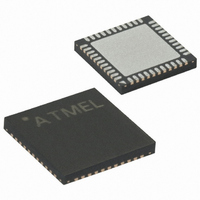ATMEGA162-16MC Atmel, ATMEGA162-16MC Datasheet - Page 180

ATMEGA162-16MC
Manufacturer Part Number
ATMEGA162-16MC
Description
IC MCU AVR 16K 5V 16MHZ 44-QFN
Manufacturer
Atmel
Series
AVR® ATmegar
Specifications of ATMEGA162-16MC
Core Processor
AVR
Core Size
8-Bit
Speed
16MHz
Connectivity
EBI/EMI, SPI, UART/USART
Peripherals
Brown-out Detect/Reset, POR, PWM, WDT
Number Of I /o
35
Program Memory Size
16KB (8K x 16)
Program Memory Type
FLASH
Eeprom Size
512 x 8
Ram Size
1K x 8
Voltage - Supply (vcc/vdd)
4.5 V ~ 5.5 V
Oscillator Type
Internal
Operating Temperature
0°C ~ 70°C
Package / Case
44-VQFN Exposed Pad
Lead Free Status / RoHS Status
Contains lead / RoHS non-compliant
Data Converters
-
- Current page: 180 of 289
- Download datasheet (3Mb)
Using MPCM
180
ATmega162(V/U/L)
The Multi-processor Communication mode enables several slave MCUs to receive data
from a Master MCU. This is done by first decoding an address frame to find out which
MCU has been addressed. If a particular slave MCU has been addressed, it will receive
the following data frames as normal, while the other slave MCUs will ignore the received
frames until another address frame is received.
For an MCU to act as a Master MCU, it can use a 9-bit character frame format (UCSZ =
7). The ninth bit (TXB8) must be set when an address frame (TXB8 = 1) or cleared when
a data frame (TXB = 0) is being transmitted. The slave MCUs must in this case be set to
use a 9-bit character frame format.
The following procedure should be used to exchange data in Multi-processor Communi-
cation mode:
1. All Slave MCUs are in Multi-processor Communication mode (MPCM in UCSRA
2. The Master MCU sends an address frame, and all slaves receive and read this
3. Each Slave MCU reads the UDR Register and determines if it has been
4. The addressed MCU will receive all data frames until a new address frame is
5. When the last data frame is received by the addressed MCU, the addressed
Using any of the 5- to 8-bit character frame formats is possible, but impractical since the
receiver must change between using n and n+1 character frame formats. This makes
full-duplex operation difficult since the Transmitter and Receiver uses the same charac-
ter size setting. If 5 to 8 bit character frames are used, the Transmitter must be set to
use two stop bit (USBS = 1) since the first stop bit is used for indicating the frame type.
Do not use Read-Modify-Write instructions (SBI and CBI) to set or clear the MPCM bit.
The MPCM bit shares the same I/O location as the TXC flag and this might accidentally
be cleared when using SBI or CBI instructions.
is set).
frame. In the slave MCUs, the RXC flag in UCSRA will be set as normal.
selected. If so, it clears the MPCM bit in UCSRA, otherwise it waits for the next
address byte and keeps the MPCM setting.
received. The other Slave MCUs, which still have the MPCM bit set, will ignore
the data frames.
MCU sets the MPCM bit and waits for a new address frame from master. The
process then repeats from 2.
2513C–AVR–09/02
Related parts for ATMEGA162-16MC
Image
Part Number
Description
Manufacturer
Datasheet
Request
R

Part Number:
Description:
Manufacturer:
Atmel Corporation
Datasheet:

Part Number:
Description:
IC AVR MCU 16K 16MHZ 5V 44TQFP
Manufacturer:
Atmel
Datasheet:

Part Number:
Description:
IC AVR MCU 16K 16MHZ 5V 40DIP
Manufacturer:
Atmel
Datasheet:

Part Number:
Description:
IC AVR MCU 16K 16MHZ 5V 44-QFN
Manufacturer:
Atmel
Datasheet:

Part Number:
Description:
IC MCU AVR 16K 5V 16MHZ 44-TQFP
Manufacturer:
Atmel
Datasheet:

Part Number:
Description:
IC MCU AVR 16K 5V 16MHZ 44-QFN
Manufacturer:
Atmel
Datasheet:

Part Number:
Description:
MCU AVR 16KB FLASH 16MHZ 44QFN
Manufacturer:
Atmel
Datasheet:

Part Number:
Description:
MCU AVR 16KB FLASH 16MHZ 44TQFP
Manufacturer:
Atmel
Datasheet:

Part Number:
Description:
IC MCU AVR 16K 5V 16MHZ 44-TQFP
Manufacturer:
Atmel
Datasheet:

Part Number:
Description:
IC MCU AVR 16K 5V 16MHZ 40-DIP
Manufacturer:
Atmel
Datasheet:

Part Number:
Description:
IC MCU AVR 16K 5V 16MHZ 40-DIP
Manufacturer:
Atmel
Datasheet:

Part Number:
Description:
IC MCU AVR 16K 5V 16MHZ 44-TQFP
Manufacturer:
Atmel
Datasheet:

Part Number:
Description:
IC MCU AVR 16K 5V 16MHZ 44-QFN
Manufacturer:
Atmel
Datasheet:










